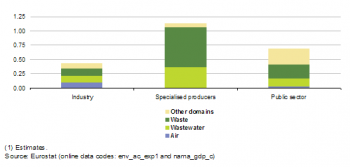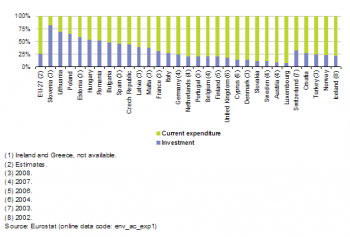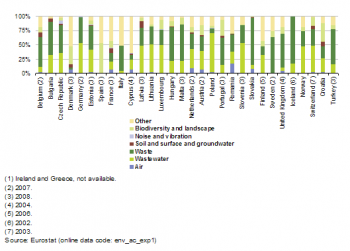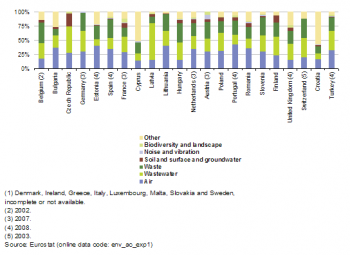Archive:Environmental protection expenditure
- Data from July 2012, most recent data: Further Eurostat information, Main tables and Database.
This article provides details on the expenditure carried out in the European Union (EU) with the purpose of protecting the environment. This covers the money spent on activities directly aimed at the prevention, reduction, and elimination of pollution or any other degradation of the environment.

2001-2009 (1)
(EUR million and % of GDP) - Source: Eurostat (env_ac_exp1)

EU-27, 2009 (1)
(% of GDP) - Source: Eurostat (env_ac_exp1) and (nama_gdp_c)

(% of GDP) - Source: Eurostat (env_ac_exp1), (env_ac_exp1r2) and (nama_gdp_c)

(% of total)- Source: Eurostat (env_ac_exp1) and (env_ac_exp1r2)

(% of total)- Source: Eurostat (env_ac_exp1) and (env_ac_exp1r2)

(% of GDP) - Source: Eurostat (env_ac_exp1), (env_ac_exp1r2) and (nama_gdp_c)

(% of total)- Source: Eurostat (env_ac_exp1) and (env_ac_exp1r2)

(% of GDP) - Source: Eurostat (env_ac_exp1), (env_ac_exp1r2) and (nama_gdp_c)

(% of total)- Source: Eurostat (env_ac_exp1) and (env_ac_exp1r2)
This article provides details on the expenditure carried out in the European Union with the purpose of protecting the environment. This covers the money spent on activities directly aimed at the prevention, reduction, and elimination of pollution or any other degradation of the environment.
Nowadays, the protection of the environment is integrated into many policy fields with the general aim of attaining sustainable development. Clean air, water and soils, healthy ecosystems and biodiversity are vital for human life, and thus it is not surprising that societies devote large amounts of money to curbing pollution and preserving a healthy environment.
Main statistical findings
Environmental protection expenditure (EPE) can be analysed looking at three main actors: the public sector, industry (mining and quarrying, manufacturing and electricity, gas and water supply) and specialised producers of environmental services (public and private enterprises specialised in producing environmental services such as waste collection).
Specialised producers accounted for the highest level of environmental protection expenditure in the EU-27 (EUR 132 900 million in 2009). The public sector and industry had expenditure of EUR 80 800 million and EUR 50 700 million respectively.
Between 2001 and 2009, the EU-27 expenditure of specialised producers grew in value terms by almost 50 % (see Figure 1). There was a 27 % increase in environmental protection expenditure made by the public sector between 2002 and 2009, while the expenditure for industry was largely unchanged (having dipped during the early part of the decade when industrial activity was relatively weak, before rebounding between 2004 and 2008).
Contrary to the general development of rising EU-27 environmental protection expenditure over most of the last decade, the latest growth rates between 2008 and 2009 reflect, at least to some degree, the impact of the financial and economic crisis. There was a reduction of 8.3 % in the expenditure made by industry, while expenditure declined by 2.6 % for specialised producers and 0.6 % for the public sector.
In terms of GDP, the EU-27 environmental protection expenditure of specialised producers increased by 0.2 percentage points between 2001 and 2009 to reach 1.1 % of GDP (see Figure 2). The relative importance of EU-27 environmental protection expenditure made by the public sector was stable at around 0.7 % of GDP between 2002 and 2008, increasing somewhat in 2009. In contrast, the relative importance of EU-27 environmental protection expenditure made by industry declined between 2001 and 2003 by about 0.1 percentage points and then remained relatively stable until 2009.
Between 2008 and 2009 there was a 5.8 % reduction in EU-27 GDP in current price terms. This decline in economic activity was at a more rapid pace than the reduction in EU-27 environmental protection expenditure for specialised producers or the public sector, resulting in their relative shares of GDP rising in 2009 while there was a very small reduction in the relative share of industrial environmental protection expenditure.
In 2009 the largest domain of EP expenditure concerned waste management, followed by wastewater treatment (see Figure 2). More than half of the expenditure within these two domains was accounted for by specialised producers. Environmental protection expenditure related to air pollution accounted for a quarter of the total expenditure made within industry.
Environmental protection expenditure by the public sector
In most European countries, environmental protection expenditure made by the public sector accounted for between 0.25 % and 0.9 % of GDP in 2009 (see Figure 3). Croatia (0.02 %), Latvia (0.08 %, 2008) and Estonia (0.16 %, 2008) were below this range, while relatively high levels of public sector expenditure were recorded in Malta (1.59 %, 2008), the Netherlands (1.58 %, 2007) and Lithuania (1.19 %).
Figure 4 provides a breakdown of the investments and current expenditure incurred by the public sector: it shows that investment for the EU-27 accounted for one quarter of the total expenditure. Investment generally accounted for a much higher share of total expenditure in most of the Member States that joined the EU in 2004 or 2007; this may reflect expenditure on fixed assets required to meet EU environmental legislation.
Waste management and wastewater treatment are the two main domains for public sector expenditure in most EU Member States (see Figure 5). Exceptions to this are Spain, where the public sector principally directed its expenditure towards biodiversity and landscape protection, and Cyprus, Italy, Denmark, France and Finland, where more than two fifths of expenditure was in the miscellaneous category of ‘other’, which includes general environmental administration and management, education, training and information relating to the environment as well as activities leading to indivisible expenditure and activities not elsewhere classified.
Environmental protection expenditure by specialised producers
The expenditure of specialised producers generally ranged between 0.4 % and 1.5 %, with an EU-27 average of 1.1 % of GDP in 2009 (see Figure 6). Only Slovakia, Finland (2006), Bulgaria, Latvia and Luxembourg had a lower level of expenditure. The highest ratios were recorded in Estonia (2008) and Austria (2007). The differences between countries may, at least to some degree, reflect whether the public sector provides services itself, or whether these activities have been contracted out to specialised producers. The differences may also be related to the specialisation and concentration of particular industrial activities within each country. For example, wastewater treatment or waste management may be internalised within industrial plants in order to recycle or re-use some of the materials that are discarded as part of the production process.
The vast majority of the environmental protection expenditure made by specialised producers was allocated to waste management and wastewater treatment (see Figure 7).
Environmental protection expenditure by industry
An average of 0.43 % of GDP was spent on environmental protection expenditure by industry across the EU-27 in 2009 (see Figure 8). This ratio was generally within the range of 0.2 % to 0.8 % of GDP. Belgium (2002), Italy (2007) and Bulgaria reported higher shares and France (2007) lower share; Turkey also had a relatively low share (2008).
The majority of the environmental protection expenditure made within industry can be attributed to manufacturing (65.7 % of the total in the EU-27 in 2009). This high share is not surprising as this sector is far larger according to most economic measures than either mining and quarrying or the electricity, gas and water supply sector. However, natural resource endowments, as well as industrial specialisation may, at least in part, explain some of the differences between countries. For example, a higher reliance on the burning of fossil fuels to generate electricity in many of the Member States that joined the EU in 2004 or 2007 may explain the relatively high degree of environmental protection expenditure within the electricity, gas and water supply sector in these countries (for example Latvia, Bulgaria, Estonia (2008) and Slovenia), while significant coal mining may explain the higher than average levels of expenditure for the mining and quarrying activity in Romania, the Czech Republic and Poland.
Environmental protection expenditure made by the industrial sector focused on air protection measures, wastewater treatment and waste management activities (see Figure 9).
Data sources and availability
Eurostat regularly collects environmental protection expenditure data through a joint Eurostat/OECD questionnaire on environmental protection expenditure and revenues; this is based on EU methodology.
The questionnaire classifies the units of the economy into four main sectors: specialised producers (in other words, public and private enterprises) of environmental protection services, the public sector (other than public specialised producers), business (other than private specialised producers) and households. In the most European countries the important environmental protection services (such as waste management and wastewater treatment) have evolved from being primarily provided free by the public sector (local government) to being more commonly provided by various forms of private and public specialised producers; the methodology used for the collection of data reflects these arrangements.
The grouping of economic units is based upon the type of environmental protection activity they carry out. Units classified under the public sector or as specialised producers of environmental protection services are units that carry out environmental protection activities for third parties.
The public sector comprises those units which carry out non-market activities for the community as a whole. Apart from legislative and regulatory tasks, public sector units may also provide environmental public goods and services. They also subsidise environmental protection activities, for example, by providing investment grants.
Public and private specialised producers produce market services.
Units that carry out environmental protection activities for their own internal use are part of the business sector. Internal (ancillary) activities are carried out on their own behalf to reduce the environmental impact of their production processes. For example, businesses can invest in equipment for cleaning up pollutants (for example, filters), cleaner production technologies that reduce emissions, or they can treat their own waste.
The business sector includes all activities in NACE Rev. 1.1 Divisions 01 to 99 (NACE Rev. 2 Divisions 01 to 99), excluding the public sector (falling mainly in NACE Rev. 1.1 Division 75 / NACE Rev. 2 Division 84, public administration) and excluding the activities of specialised producers (falling mainly in NACE Rev. 1.1 Division 90, sewage and refuse disposal / NACE Rev. 2 Divisions and Classes 37, sewerage, 38.1, waste collection, 38.2, waste treatment and 39, remediation activities). For the purpose of this publication, an aggregate called industry (NACE Rev. 1.1 Sections C, D (excluding D37, recycling) and E / NACE Rev. 2 Sections and Divisions B, C, D and E36) is used.
The households sector groups together those units that belong to the institutional sector of households in the national accounts, considered in their capacity as final consumers. Households mainly buy environmental services (for example, they pay for the collection and treatment of household waste, or the treatment of their wastewater).
Environmental protection expenditure is an indicator which comprises total investments and total current expenditure. Current expenditure is the sum of internal current expenditure and the fees and other payments for environmental protection services. For the public sector, environmental protection expenditure also includes subsidies and investment grants that are paid to other sectors.
Total environmental protection expenditure gives an idea of the money spent by each sector on environmental protection activities directly and indirectly, in other words, not only on environmental protection activities for their own use, but also by those buying environmental services from other economic units and financing environmental protection expenditure that is carried out by other units. Note that this total environmental protection expenditure is not adjusted to take account of receipts from any by-products, revenues from environmental protection services or from transfers/subsidies.
The indicators for environmental protection expenditure can be used to compare the performance of a particular sector across countries. However attention is needed when the indicator is used to compare expenditure across sectors, as there may be cases of double-counting, in particular, between specialised producers of environmental protection services and those business that purchase such services.
The scope of environmental protection is defined according to the Classification of Environmental Protection Activities (CEPA 2000), which distinguishes nine different environmental domains: the protection of ambient air and the climate; wastewater treatment; waste management; protection and remediation of soil, groundwater and surface water; noise and vibration abatement; protection of biodiversity and landscape; protection against radiation; research and development, and other environmental protection activities.
Context
The demand for goods and services to prevent or treat environmental damage encourages environmental activities and stimulates the development of a ‘greener’ economy. The analysis of expenditure patterns relating to environmental protection may contribute towards an evaluation of environmental policies already in place and whether or not the ‘polluter pays’ principle is being implemented.
A low level of environmental protection expenditure does not necessarily mean that a country is not effectively protecting its environment. In fact, the indicator tends to emphasise clean-up costs at the expense of cost reductions which could be due to reduced emissions or more effective (less polluting) production techniques.
For many years, European statistical services have collected data on air pollution, energy and water consumption, wastewater, solid waste, and their management. The data sources can be used by policymakers to assess the environmental impact of economic activities (resource consumption, air or water pollution, waste production) and to assess the actions (investments, technologies, expenditure) that may be carried out to limit the causes and risks of pollution.
Eurostat has worked towards systematically gathering environmental statistics for all economic sectors within the EU. These statistics are used to assess the effectiveness of new regulations and policies and analyse the links between environmental pressures and the structure of the economy.
A Regulation (691/2011) on European environmental economic accounts was adopted on 6 July 2011. The Regulation provides a framework for the development of various types of environmental accounts. Although not included in the first set of modules, the Regulation does make reference to environmental protection expenditure as a future area for inclusion.
Further Eurostat information
Publications
- Environmental protection expenditure in Europe - Data 1995-2009 - Statistical book, 2011
- Energy, transport and environment indicators pocketbook, 2011 - Statistical pocketbook, 2011
- Environmental statistics and accounts in Europe - Statistical book, 2010
- Environmental Protection Expenditure and Revenues in the EU, EFTA and candidate countries, 2001-2006 - Statistics in Focus 31/2010
- Environmental Protection Expenditure by Industry in the European Union 1997-2004 - Statistics in Focus 93/2008
- Environmental Protection Expenditure in Europe by public sector and specialised producers 1995-2002 - Statistics in Focus 10/2005
- Environmental protection expenditure by industry in the European Union - Statistics in Focus 14/2002
- Environmental protection expenditure in accession countries, Data 1996-2000 - Statistical book, 2002
- Environmental protection expenditure in Europe, Data 1990-1999 - Statistical book, 2001
Main tables
- Environment (env), see:
- Environmental expenditure by public sector (ten00049)
- Current environmental expenditure by public sector (ten00051)
- Current environmental expenditure by industry (ten00054)
- Environmental investment by public sector (ten00050)
- Environmental investment by industry (ten00053)
- Environmental protection expenditure by industry (ten00052)
- Environmental protection spending by industry (ten00052)
Database
- Environment (env), see:
- Environmental Accounts (env_acc)
- Environmental protection expenditure in Europe - detailed data (NACE Rev. 1.1)
- Environmental protection expenditure in Europe - detailed data (NACE Rev. 2)
- Environmental protection expenditure in Europe - indicators: Euro per capita and % of GDP
- Environmental protection expenditure in Europe - indicators: % Pollution prevention, % of gross fixed capital formation, % of output
- Environmental protection expenditure by NUTS 2 regions (NACE Rev. 1.1)
- Environmental protection expenditure by NUTS 2 regions (NACE Rev. 2)
- Environmental protection expenditures by EU institutions
Dedicated section
Methodology/Metadata
- Environmental expenditure statistics: General Government and Specialised Producers data collection handbook, 2007
- Environmnetal expenditure statistics: Industry data collection handbook, 2005
- OECD/Eurostat Environmental Protection Expenditure and Revenues Joint Questionnaire/SERIEE Environmental Protection Expenditure Account: Conversion Guidelines, 2005
- SERIEE - Environmental protection expenditure accounts - Compilation Guide, 2002
- SERIEE - European System for the collection of economic information on the environment, 1994 version
- Environmental protection expenditure in Europe - detailed data (ESMS metadata file - env_ac_exp1_esms)
- Environmental protection expenditure in Europe - detailed data (NACE Rev. 2) (ESMS metadata file - env_ac_exp1r2_esms)
- Environmental protection expenditure in Europe - indicators: Euro per capita and % of GDP (ESMS metadata file - env_ac_exp2_esms)
- Environmental protection expenditure in Europe - indicators: % Pollution prevention, % of gross fixed capital formation, % of output (ESMS metadata file - env_ac_exp3_esms)
- Environmental protection expenditure by NUTS 2 regions (NACE Rev. 1.1) (ESMS metadata file - env_ac_exp4_esms)
- Environmental protection expenditure by NUTS 2 regions (NACE Rev. 2) (ESMS metadata file - env_ac_exp4r2_esms)